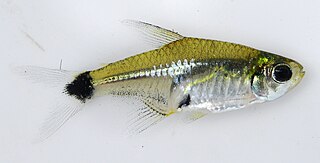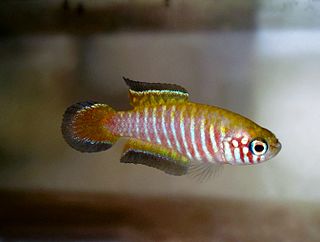
The Doradidae are a family of catfishes also known as thorny catfishes, raphael catfishes or talking catfishes. These fish are native to South America, primarily the Amazon basin and the Guianas.

Rineloricaria is a genus of freshwater tropical catfish belonging to the family Loricariidae. They are commonly called whiptail catfish because of the long filament that grows out of the tip of the caudal fin that is characteristic of the genus. With the exception of R. altipinnis from Panama, they are native to the rivers of northern and central South America. Some species are regularly seen in the aquarium trade.

Trichomycterus is a genus of fish in the family Trichomycteridae, the largest genus of its family with over 170 species currently described. This genus is native to freshwater habitats in Central and South America. These fish are generally small, usually about 5 to 15 cm (2–6 in) in standard length, although the largest, T. rivulatus, can reach more than twice this size. Species differ from one another primarily in body proportions, fin ray counts and colouration. Despite their relatively small size, some, such as T. punctulatus, support fisheries and are important in the local cuisine.

The spotted nothura is a species of tinamou. This bird is native to grassy habitats in eastern and southern Brazil, Paraguay, Uruguay, and eastern and northern Argentina.

The Hypoptopomatinae are a subfamily of catfishes of the family Loricariidae, composed of 17 genera and approximately 80 species. This subfamily represents about one-tenth of all loricariid species.
Microlepidogaster is a genus of armored catfishes native to South America.

Parotocinclus is a genus of fish in the family Loricariidae native to South America. This genus is distributed through almost all hydrographic systems in South America from the Guyana Shield drainages and Amazon Shield tributaries to the coastal drainages of eastern and southeastern Brazil, including the rio São Francisco basin. Most species have the caudal peduncle oval in cross section. It has been found that Characidium species may interact with P. maculicauda. The small Characidium will follow grazing P. maculicauda, which release particulate matter dislodged from the catfish's foraging.
Neoplecostomus is a genus of fish in the family Loricariidae native to South America. Neoplecostomus can be distinguished from all other loricariids by a modified shield of small plates on the abdomen with posteriorly directed odontodes; the shield appears to act as a holdfast. The color pattern is generally mottled brown with the abdomen white. The head is long, rounded, and shovel-shaped. The fin spines are weak. They range from about 8 to 11 cm (3.1–4.3 in) SL. The species of Neoplecostomus live in fast-flowing water.
Pareiorhina is a genus of armored catfishes native to South America where they are only found in Brazil. These species are known to occur at altitudes above 650 metres (2100 ft) in various rivers of the Grande, Paraíba do Sul, São Francisco and Tietê River basins. This genus was first erected by Gosline in 1947 as a monotypic genus to include Rhinelepis rudolphi. It was not until 2003 that a second species, P. carrancas, was described. The third species, P. brachyrhyncha was described in 2005. Pareiorhina forms a monophyletic subunit with Neoplecostomus within the subfamily Neoplecostominae.
Microcambeva is a genus of catfishes of the family Trichomycteridae.

The Araçuaí River is a river of Minas Gerais state in southeastern Brazil. The Araçuaí River flows through the Jequitinhonha Valley in the northeast of Minas Gerais, through the town of Araçuaí, which the river takes its name from. It is a tributary of the Jequitinhonha River, flowing south from its right bank. The confluence of the river is located at 16°45′45″S42°0′32″W. Tributaries include the Gravatá River, Setúbal River, Capivara River, Fanado River and the Itamarandiba River.

The Brazilian gold frog, also known as Izecksohn's toad or flea-frog, is a very small species of frogs in the family Brachycephalidae. It is endemic to southeastern Brazil and is known from the central part of the state of Rio de Janeiro and from Serra das Torres in extreme southern Espírito Santo.
Nematocharax is a genus of freshwater fish in the family Characidae. It contains the single species Nematocharax venustus, which is endemic to Brazil, where it is found in the Jequitinhonha River basin. The males of this species can reach a length of 5.1 centimetres (2.0 in) SL while the females only grow to 3.5 centimetres (1.4 in) SL.

Serrapinnus is a genus of characins from tropical South America.

Simpsonichthys is a genus of killifish from the family Rivulidae the species of which are endemic to temporary freshwater habitats like ponds in the upper Paraná, upper Araguaia, upper Jequitinhonha and São Francisco basins on the central Brazilian Plateau. They are small annual killifish that reach up to 5.5 cm (2.2 in) in standard length.
Chauliocheilos saxatilis is a species of armored catfishes native to South America. This species occurs Rio Itamarandiba in upper Rio Jequitinhonha basin, southeastern Brazil. This species is the only known member of its genus.
Microlepidogaster arachas is a species of armored catfish endemic to tributaries of the rio Araguari, rio Perdizes, and rio Dourados, all pertaining to the rio Paranaíba drainage, upper rio Paraná basin in Brazil.
Microlepidogaster discontenta is a species of armored catfish endemic to and found in the tributaries of the Rio São Francisco basin in Brazil.
Simpsonichthys margaritatus is a species of killifish from the family Rivulidae. It is found in the Verde River floodplains, of the upper Paraná River basin in central Brazil.
Simpsonichthys espinhacensis is a species of killifish from the family Rivulidae. It is found in the upper Jequitinhonha River basin in Minas Gerais, eastern Brazil. The specific name refers to the Espinhaço Mountains where the known range of this species lies.









